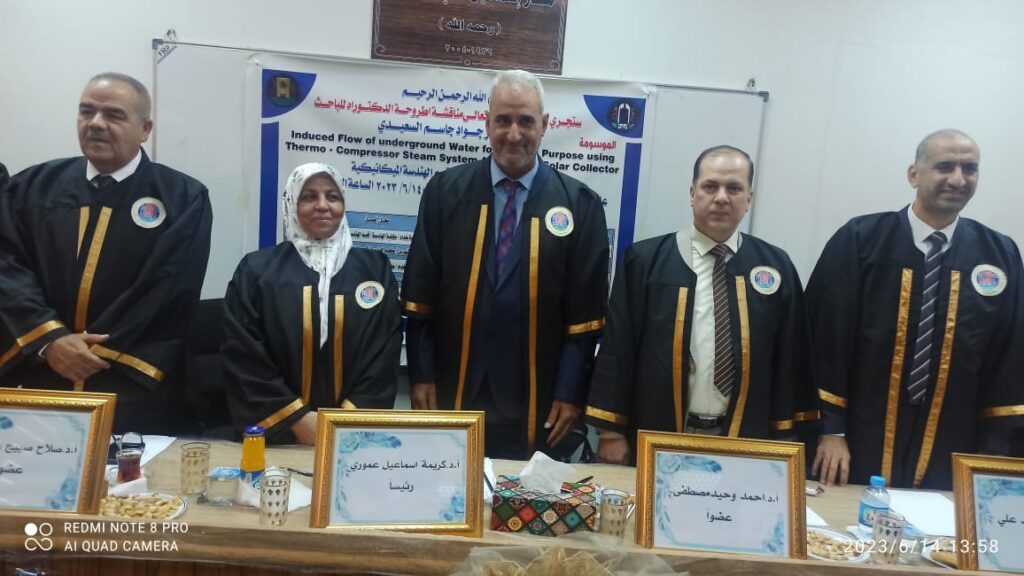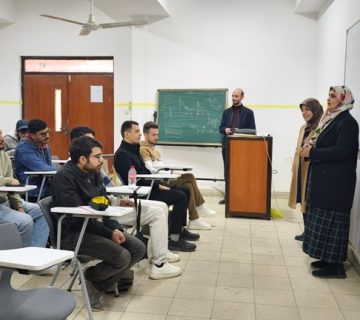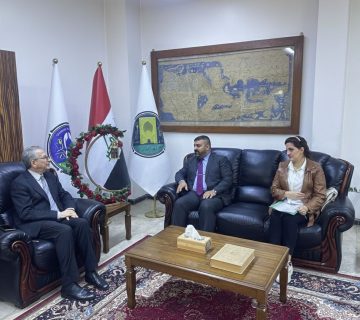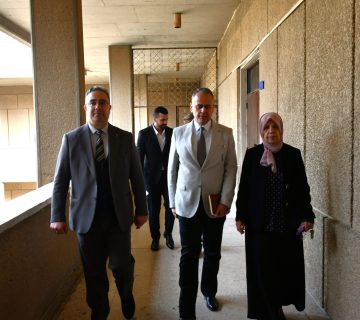It was conducted on Wednesday 14/6/2023, in hall of Dr. Munther Al-Droubi the discussion of the doctoral dissertation of the student Shakir Jawad Jasim, which is tagged:
“Induced flow of underground water for cooling purpose using thermo-compressor steam system assisted by solar collector”.
The discussion committee consisted of names listed below:
Prof. Dr. Karima E. Amori – University of Baghdad / College of Engineering / Department of Mechanical Engineering – Chairman.
Prof. Dr.Ahmed Waheed Mustafa – Al-Nahrain University / College of Engineering / Department of Mechanical Engineering – Member.
Prof. Dr. Salih S. Abed – University of Baghdad / College of Engineering / Department of Mechanical Engineering – Member.
Prof. Dr. Issam M. Ali – University of Baghdad/ College of Engineering/ Department of Mechanical Engineering– Member.
Assist. Prof. Dr. Luma F. Ali – University of Baghdad/ University of Baghdad/ College of Engineering/ Department of Mechanical Engineering – Member.
Prof. Dr. Akram W. Ezzat – University of Baghdad/ College of Engineering/ Department of Mechanical Engineering– Supervisor.
The dissertation was summarized as follows:
The best alternative option for vapor compression refrigeration is the ejector refrigeration powered by solar thermal energy, which is used to decrease the electricity consumption. The present work emphasizes on studying water evaporative cooling induced by steam jet thermo-compressor assisted by solar collector. Underground water has been chosen as working fluid in this work.
The theoretical analysis, which was constructed, depends on solving conservation equations for primary and secondary streams, considering flow compressibility in the steam ejector nozzle. A one-dimensional thermodynamic model was developed for the ejector refrigeration system to investigate the system performance by treating the working fluid as a real fluid. A two-dimensional numerical simulation using computational fluid dynamics was performed to analyze flow behavior through the ejector. The experimental test rig was designed, fabricated, and assembled for the simple and modified steam ejector refrigeration system. The design criteria of the experimental parts of the system depend on estimating the heat required for steam production in the main ejector streamline to initiate a proper vacuum in the water evaporation vessel by an adequately designed supersonic steam ejector. The generation of the thermal power required for primary steam production could be get by using both steam boiler and properly designed solar thermal collector. The steam ejector outlet is connected to the condenser to ensure a proper condensation process for the steam and collect the water in a vessel. The design of the modified experimental system is based on open cycle in which the evaporator is connected to the underground water instead of the condensation water.
The one-dimensional thermodynamic model and two-dimensional numerical simulation were validated by comparison their results with the experimental results. It was found that the entrainment ratio and critical back pressure obtained from the 2-D numerical approach were very close to the experimental results than the 1-D mathematical approach. The maximum entrainment ratio deviation simulated was -3.66% and the critical back pressure deviation simulated was 3.1% for the 2-D model while The maximum entrainment ratio deviation calculated was 6.66% and the critical back pressure deviation calculated was -12.46% for the 2-D model .
The results showed that the maximum electrical coefficient of performance obtained from the experimental test rig is 0.45 at generator, evaporator, and condenser temperatures of 110°C, 10°C, and 25°C respectively and nozzle throat diameter of 2.4 mm. While the maximum electric coefficient of performance was found to be 0.55 at the same above conditions when using a flat plate solar collector of 2m2 and the solar incident of 700 w/m2 at a tilt angle of 15o. The maximum estimated solar collector area required to generate the steam without using electricity in the boiler for the steam system with a cooling load of 1 kW used in the test was 29.87 m2 at generator, evaporator, and condenser temperatures of 140°C, 10°C, and 45°C respectively, the nozzle throat diameter of 2.8 mm, the same orientation of flat plate and solar incident. The results also showed that connecting the underground water to the evaporating vessel instead of the condenser water increases the cooling load. With using underground water, the cooling load could be increased by increasing condenser temperature, evaporator temperature, nozzle throat diameter or decreasing boiler temperature.
After scientific discussions by the discussion committee members on the contents of the dissertation in-depth and expressing their observations, directives, and defense by the student, the dissertation was accepted and the student was awarded the Ph.D. in mechanical engineering sciences/ Thermo-Fluids with a grade of very good.









